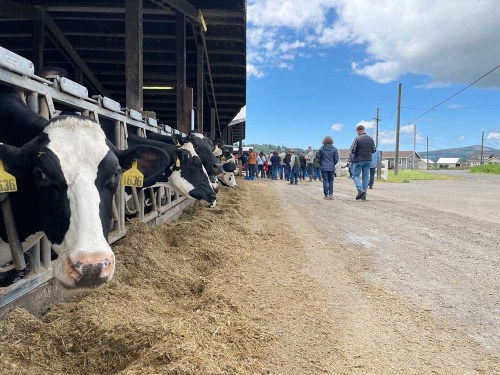Tour gives county commissioners perspective on working lands
Published 4:00 pm Tuesday, June 7, 2022

- County commissioners from across Oregon stroll past a row of Holstein cows at Kuipers Farms in Tillamook, part of a tour of the area's working lands.
TILLAMOOK, Ore. — Not long after he was first elected in 2016, Tillamook County Commissioner David Yamamoto made a bold claim at an Association of Oregon Counties training program.
“I stood up before AOC — there must have been 150 commissioners from across the state there — and I just said, when it comes to clean water, habitat restoration and fish recovery, no Oregon county does this better than Tillamook County,” he remembered. “And 150 pairs of eyes rolled across the room.”
Trending
It was then that Yamamoto started bringing his fellow commissioners to Tillamook County on Oregon’s North Coast. The goal, he said, was to show how they work with farms, forests and fisheries to provide local jobs while also protecting the environment and water quality.
On June 6, about 25 county commissioners from across the state gathered again in Tillamook. The daylong bus tour featured stops at Hampton Lumber’s Tillamook mill, the Trask River Hatchery, forestland managed by Stimson Lumber Co. and Kuipers Farms, a family-owned dairy.
Tours are organized by the Tillamook Working Lands & Waters Cooperative, a grassroots group that formed around the county’s natural resource-based economy.
“It’s strictly educational,” Yamamoto said. “We don’t try to ram anything down anyone’s throat. We just show them how we do it here, how we collaborate between the industry and our communities and neighbors, and we let people make up their own minds.”
According to the state Employment Department, agriculture, forestry, fishing and hunting accounted for 741 jobs in Tillamook County in 2021. Food and wood products manufacturing totaled another 1,295 jobs.
Combined, the sectors make up more than 20% of the county’s total employment with an average annual wage of $57,993, about 22% higher than the county average for all jobs.
Trending
Yamamoto said the cooperative was assembled by Oregonians for Food and Shelter, a nonprofit advocacy group. The co-op is supported by members of the farming, forestry and fishing communities.
The tour began with a presentation by Chad Washington, stewardship and community engagement coordinator for Lewis and Clark Timberlands, who in part discussed the Oregon Private Forest Accord that was signed into law last month.
Negotiated between timber and environmental interests, the accord represents a “paradigm shift” in forest policy, Washington said. Private timberland owners hope the compromise will provide greater regulatory certainty, thereby attracting more investments in their businesses.
From there, commissioners loaded onto buses, stopping first outside the Hampton Lumber mill followed by a visit to the Oregon Department of Fish and Wildlife’s Trask River Hatchery, which was remodeled last year.
The hatchery raises 150,000 fall chinook, 400,000 spring chinook and 100,000 wild brood coho salmon that are released into the Trask River every year. Another 100,000 brood stock winter steelhead are also released in the Wilson River.
The tour then proceeded to a roughly 90-acre timber site overlooking Netarts Bay that was last logged by Stimson Lumber in 2017, and replanted the following year.
Jon Wehage, the company’s coast unit manager, talked about how the project was coordinated between state agencies and the Netarts Water District to avoid drinking water contamination.
“There’s a lot of long-term planning that takes place here,” he said. “Protecting water and managing the resource are not mutually exclusive.”
The tour concluded at Kuipers Farms, a member of the Tillamook County Creamery Association. The dairy milks between 550 and 600 cows, including Holsteins and Jerseys.
Garritt Kuipers, one of the family members, embraced the tour’s educational mission.
“It’s really hard to run a family farm like this when people who know nothing about the business are telling you what you can and cannot do,” Kuipers said. “If you want to keep dairies in (Oregon and Washington), we gotta have common sense, not activism.”
James Williams, a Lake County commissioner in southcentral Oregon, said he came away from the tour with a greater sense of how connected Oregon is.
“In a day and age where everyone is talking about maybe going to Idaho, or the state needs to split up and we have that rural-urban divide, I think it’s great showing that we are actually more connected than we are divided,” Williams said.





